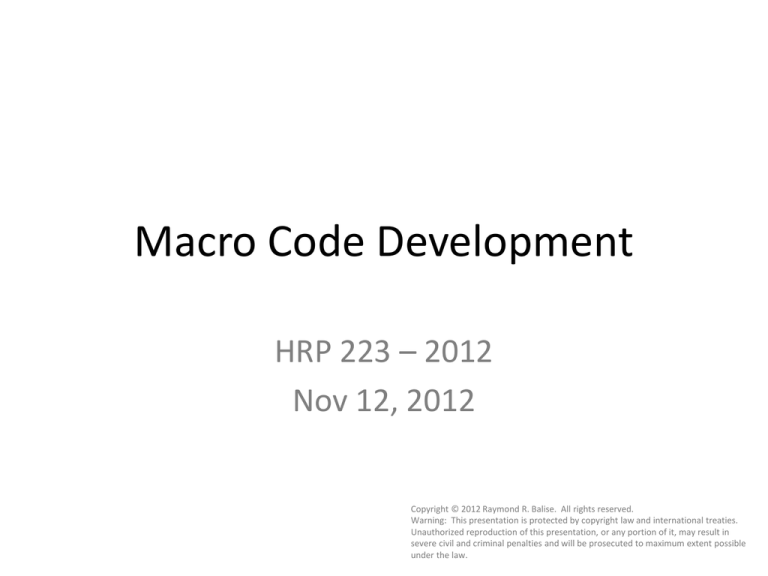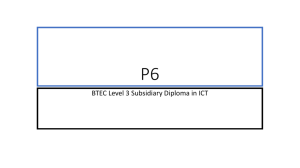
Macro Code Development
HRP 223 – 2012
Nov 12, 2012
Copyright © 2012 Raymond R. Balise. All rights reserved.
Warning: This presentation is protected by copyright law and international treaties.
Unauthorized reproduction of this presentation, or any portion of it, may result in
severe civil and criminal penalties and will be prosecuted to maximum extent possible
under the law.
1
Keyboard Macros vs. Macros
• Keyboard/Editor macros
• Macros
– are programs
– automate tasks
– facilitate sharing solutions to complex problems
2
Graphic for Rare Diseases
3
Recycling is Efficient
4
Using a Macro in EG
https://www.stanford.edu/~balise/CPIC/plotIt
5
Using a Macro in SAS
https://www.stanford.edu/~balise/CPIC/plotItSAS
6
The definition of the plotit macro is here.
This creates the macro but does not cause
it to do anything. Expand the code if, and
only if, you want to.
Arguments are hopefully well named. They
are a comma-delimited list. A modern
macro will include comments like this for
Enterprise Guide to display.
%mend = macro end goes after
the code.
This calls/invokes the plotit macro. The
macro is actually “done” when you include
a line like this.
7
Macro Details
• Macros begin with the word %macro and end with
the word %mend.
• As a user of the macro, you can ignore everything
after the %macro line.
• The first line typically has the parameters (aka
arguments) that the macro needs. Hopefully the
person who wrote the macro will give you the
details on the arguments.
– The parameters are filled in using the order you typed
them unless the arguments have a name and = .
8
Making a Macro
Replace the
analysis variable
with a macro
variable.
9
Using a Global Macro Variable
Add thingy to the global
macro value lookup
table.
This is dangerous code
because thingy will keep
the value till you quit.
Replace &thingy. with
Weight.
10
Macros Happen First
• The macro engine does the copy and paste to
resolve the meaning of macro variables before
the rest of the code is executed.
11
Macro Variables
• Macro variable names are like SAS variable
names but when you use them, precede the
name with & and follow with a .
• The final decimal point is optional but it is a
very good idea to include it.
12
Using a Local Macro Variable
Make a macro variable called
thingy that will be destroyed
when the macro is done.
Replace &thingy. with
weight on first call and
with age on second call.
13
14
Position or Named Arguments
• If you have defaults for the macro arguments,
used a named list.
• Positional arguments go first in a fixed order.
• Named arguments can be in any order. They
are called with the argument name and an =
15
Macro Statements
• You have seen %macro %mend and %let
statements.
• You can write complex macro code with %if
and %do
16
A new named argument with
a default of YES
If the plot macro variable is
YES then include the plot.
17
18
Macros Calling Macros
Hard coding these details
makes no sense.
Invoke the plotIt macro and
pass it a few parameters.
19
20
%sysfunc says to do a regular SAS
function. Here compress away the “
Pass a quoted string.
21
Other Examples
• I want to
make a
quantile plot
to show the
percentiles
for a
dataset.
22
How to do this….
• Test to see if the dataset exists and if it exists,
count the records.
• Make a temporary dataset after doing some
algebra. Then make the plot. Finally, remove
the temporary dataset.
23
Counting Records
Try to open a pipe to a file.
If it failed, say 0 records.
Otherwise get the record
count attribute.
Close the pipe.
24
Checking That it Worked
It behaves with missing data.
It returns the number of records.
25
Put the values into a string.
Put those values into a macro
variable during the run.
26
Use the values.
27
Reusing the Code
• You can keep a library of useful code and
include the snippets in your projects:
%include "c:\sasMacros\quantPlot.sas";
• Or add to the autocall library:
The folder has
quantPlot.sas and
nobsG.sas
28
Sensitivity, Specificity, Positive and
Negative Predicted Value
• Somehow SAS forgot them…
In the log
In the log
29
Binomial
Probabilities
• If you need to
calculate binomial
probabilities, look
at my macro:
Proc reliability does
confidence intervals but
it is expensive…
30
31
Macro Books
Carpenter's Complete Guide to the SAS Macro Language,
Second Edition
By: Art Carpenter
Only hard copy
SAS Macro Programming Made Easy, Second Edition
By: Michele M. Burlew
proquest.safaribooksonline.com/book/databases/sas/9781590478820
32








